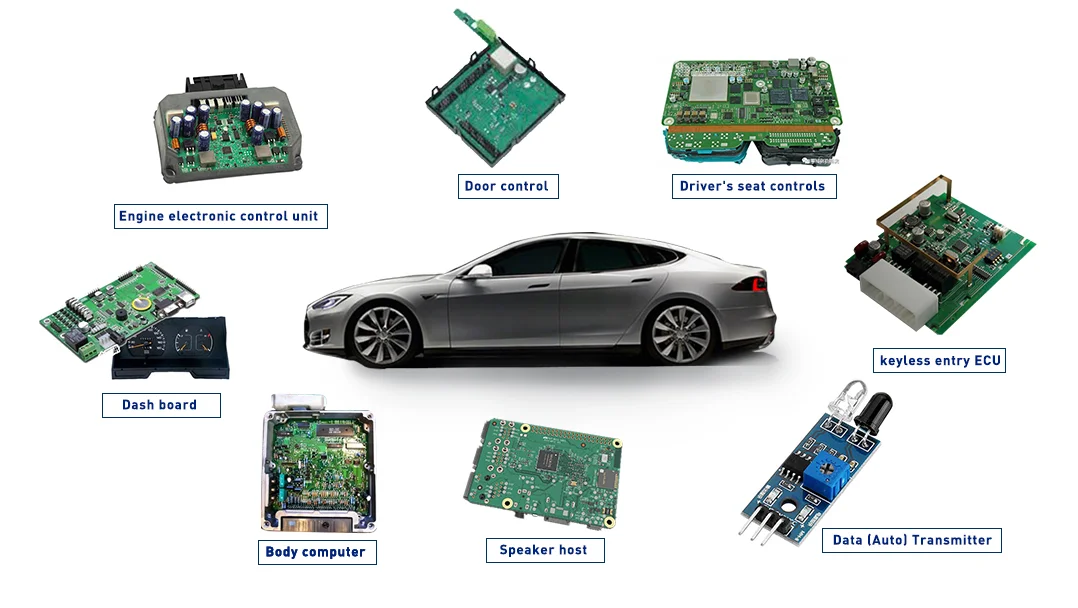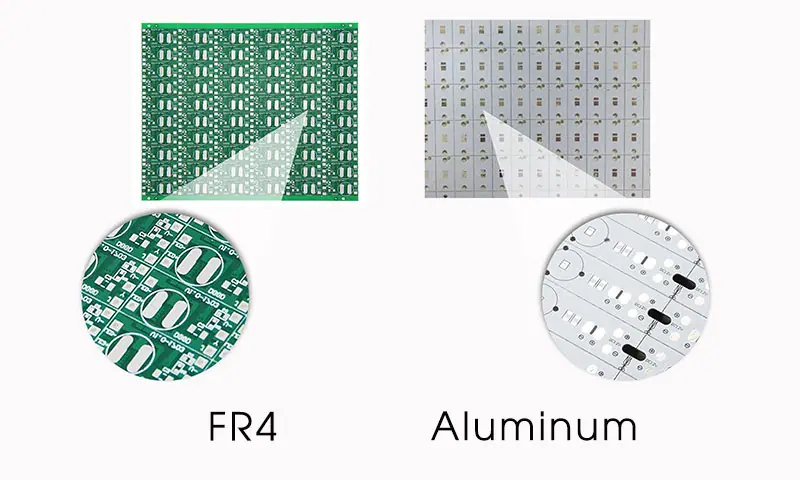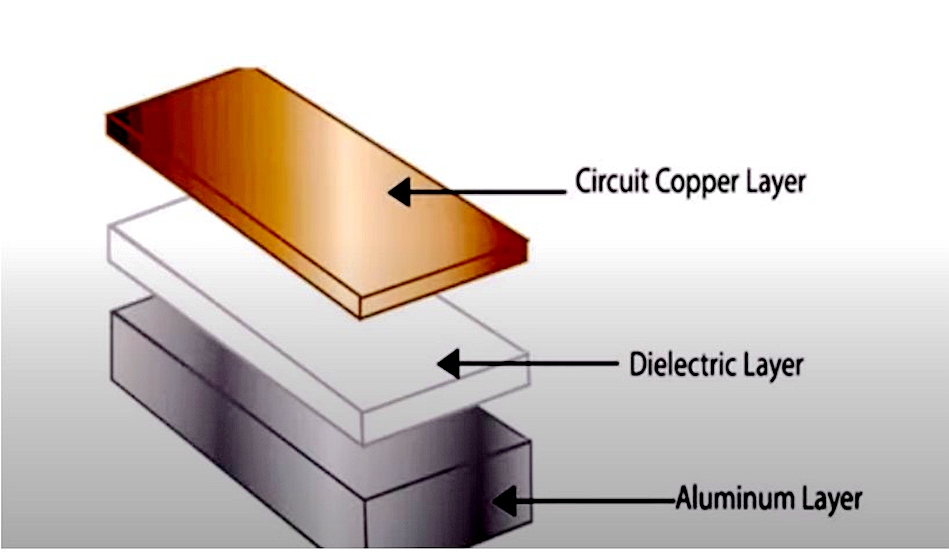In the fast-evolving world of automotive electronics, managing heat is a critical challenge. Aluminum PCBs (Printed Circuit Boards) have emerged as a powerful solution for enhancing heat resistance and ensuring reliable performance in car electronics. Whether you're searching for "aluminum PCB automotive applications," "PCB for car electronics," or "aluminum PCB heat resistance," this blog will explore how these durable boards address thermal issues and improve automotive PCB design for long-lasting performance in vehicles.
At ALLPCB, we understand the importance of reliable and efficient electronics in modern vehicles. This comprehensive guide dives deep into the benefits of aluminum PCBs, their role in solving heat-related problems, and why they are ideal for durable PCB solutions in automotive systems. Let’s explore how these innovative boards are transforming car electronics design.
Why Heat Management Matters in Automotive Electronics
Modern vehicles rely heavily on electronic systems for everything from engine control units (ECUs) to infotainment and advanced driver-assistance systems (ADAS). These components generate significant heat during operation, especially in confined spaces like a car’s engine bay or dashboard. Without proper heat dissipation, electronics can overheat, leading to reduced performance, shorter lifespans, or even complete failure.
Automotive environments are particularly harsh, with temperature ranges often fluctuating between -40°C to over 85°C, depending on the location and operating conditions. Add to this the heat generated by high-power components, and you have a recipe for thermal stress. Traditional PCBs made of materials like FR4 struggle to handle such extreme conditions, often resulting in delamination or warped boards over time. This is where aluminum PCBs shine, offering superior heat resistance and durability for automotive applications.

What Are Aluminum PCBs and How Do They Work?
Aluminum PCBs, also known as metal core PCBs (MCPCBs), are designed with a metal base layer, typically aluminum, instead of the standard fiberglass used in traditional boards. This metal layer acts as a heat sink, efficiently dissipating heat away from critical components. The structure of an aluminum PCB generally includes three layers: a circuit layer (copper foil), a dielectric layer (for insulation), and the aluminum base layer.
The key to their performance lies in the thermal conductivity of aluminum, which is significantly higher than that of FR4 materials. For instance, while FR4 has a thermal conductivity of about 0.3 W/m·K, aluminum offers a conductivity of around 1-2 W/m·K or higher, depending on the alloy and design. This allows aluminum PCBs to transfer heat away from components much faster, reducing the risk of overheating in high-power automotive applications.
In car electronics, where space is limited and components are packed tightly, this heat dissipation capability is invaluable. Aluminum PCBs ensure that sensitive parts like power transistors or LED drivers in lighting systems remain cool, even under heavy load or extreme environmental conditions.
Key Benefits of Aluminum PCBs in Automotive Applications
The aluminum PCB offers several advantages that make them a top choice for automotive PCB design. Let’s break down the most significant benefits for durable PCB solutions in vehicles.
1. Superior Heat Resistance for Harsh Environments
One of the standout features of aluminum PCBs is their exceptional heat resistance. In automotive systems, components often face high temperatures due to engine heat, direct sunlight, or internal power dissipation. Aluminum PCBs can withstand these conditions without degrading, ensuring consistent performance over the vehicle’s lifespan, which can range from 10 to 12 years on average.
For example, in engine control units located near the engine bay, temperatures can spike significantly. Aluminum PCBs help maintain safe operating temperatures, preventing thermal shutdowns or damage to critical electronics.
2. Enhanced Durability for Long-Term Reliability
Durability is a non-negotiable factor for PCBs in vehicles. Aluminum PCBs are more resistant to mechanical stress, vibration, and thermal expansion compared to standard boards. Their robust construction prevents cracking or warping, even when exposed to the constant bumps and shakes of driving conditions. This makes them a perfect fit for durable PCB solutions in vehicles, ensuring electronics remain functional over years of use.
3. Lightweight Design for Fuel Efficiency
Weight reduction is a priority in automotive design to improve fuel efficiency and reduce emissions. Aluminum PCBs are lighter than other metal core alternatives like copper, while still providing excellent PCB thermal management. This lightweight property aligns with the industry’s push for more efficient and eco-friendly vehicles, especially in electric and hybrid cars where every gram counts.
4. Cost-Effective Thermal Management
While aluminum PCBs may have a higher upfront cost compared to traditional FR4 boards, they often reduce the need for additional cooling components like heat sinks or fans. This can lower overall system costs in automotive electronics, making them a practical choice for manufacturers looking to balance performance and budget.

Aluminum PCB Automotive Applications: Where They Shine
The versatility of aluminum PCBs makes them suitable for a wide range of automotive applications. Below are some key areas where these boards play a critical role in enhancing car electronics.
1. Engine Control Units (ECUs)
ECUs are the brain of a vehicle, managing everything from fuel injection to emissions control. These units generate substantial heat and are often placed in high-temperature zones. Aluminum PCBs ensure efficient heat dissipation, protecting sensitive microcontrollers and maintaining reliable operation under extreme conditions.
2. LED Lighting Systems
Modern vehicles increasingly use LED lights for headlights, taillights, and interior lighting due to their energy efficiency and brightness. However, LEDs produce significant heat, which can degrade performance if not managed properly. Aluminum PCBs are ideal for LED drivers, providing the thermal conductivity needed to keep lights cool and extend their lifespan.
For instance, in a typical automotive LED headlight system, the driver circuit can reach temperatures of up to 80°C. An aluminum PCB can reduce this by efficiently spreading heat across the board, ensuring consistent light output and durability.
3. Power Converters in Electric Vehicles (EVs)
Electric vehicles rely on high-power electronics for battery management systems (BMS) and DC-DC converters. These components handle large currents, generating considerable heat in the process. Aluminum PCBs help manage thermal loads, preventing overheating and ensuring the safety and efficiency of EV systems.
Read More: Boosting Performance: The Role of Aluminum PCBs in Power Electronics
4. Advanced Driver-Assistance Systems (ADAS)
ADAS technologies, such as radar and camera systems, require compact, high-performance electronics that can operate reliably in varying temperatures. Aluminum PCBs provide the thermal stability and durability needed to support these safety-critical systems, ensuring they function without interruption.
Automotive PCB Design: Why Aluminum Is a Game-Changer
Designing PCBs for car electronics requires careful consideration of thermal, mechanical, and environmental factors. Aluminum PCBs offer unique advantages that make them a game-changer in automotive PCB design.
Thermal Design Flexibility
Aluminum PCBs allow engineers to design more compact and efficient systems without worrying about thermal bottlenecks. The high thermal conductivity means components can be placed closer together without risking overheating, saving valuable space in tight automotive layouts.
Compatibility with High-Power Components
Many automotive systems, such as motor controllers or power inverters, use high-power components that generate significant heat. Aluminum PCBs can handle these loads, supporting higher current densities and ensuring stable performance even at peak operation.
Suggested Reading: Why High-Power Applications Demand Aluminum PCBs
Resistance to Environmental Stress
Vehicles operate in diverse conditions, from freezing winters to scorching summers, along with exposure to humidity and dust. Aluminum PCBs are less prone to damage from thermal cycling (repeated heating and cooling), making them a reliable choice for long-term use in harsh environments.
Challenges and Considerations When Using Aluminum PCBs
While aluminum PCBs offer numerous benefits, there are some challenges to keep in mind during design and implementation.
First, aluminum PCBs can be more expensive to manufacture compared to standard FR4 boards due to the materials and processes involved. However, the long-term savings from reduced cooling needs and increased reliability often outweigh the initial cost.
Second, the dielectric layer in aluminum PCBs must be carefully selected to balance thermal conductivity and electrical insulation. A poorly chosen dielectric can lead to reduced performance or even short circuits. Working with experienced manufacturers ensures that these materials are optimized for automotive applications.
Finally, aluminum PCBs are less flexible than traditional boards, which may limit their use in applications requiring bending or unique shapes. However, for most automotive systems, their rigidity is an asset, providing added mechanical stability.
Suggested Reading: How to Choose the Best Dielectric Material for Aluminum PCBs
How to Choose the Right Aluminum PCB for Automotive Needs
Selecting the right aluminum PCB for car electronics involves evaluating several factors to ensure optimal performance and durability.
- Thermal Conductivity: Look for boards with high thermal conductivity ratings to handle the specific heat loads of your application.
- Dielectric Layer Thickness: Thinner dielectric layers improve heat transfer but may compromise insulation. Choose a thickness that balances both needs.
- Board Thickness: Thicker aluminum bases provide better heat dissipation but add weight. Consider the trade-offs based on your design constraints.
- Environmental Ratings: Ensure the PCB meets automotive standards for temperature, vibration, and humidity resistance, such as those outlined in AEC-Q100 or ISO 16750.
Partnering with a trusted PCB provider can simplify this process, ensuring that the boards are tailored to the unique demands of automotive electronics.

Future Trends: Aluminum PCBs in Next-Generation Vehicles
As vehicles become more connected and electrified, the demand for high-performance, durable PCBs will continue to grow. Aluminum PCBs are poised to play a central role in this evolution, supporting the thermal and mechanical needs of emerging technologies.
For instance, the rise of autonomous driving systems will require even more powerful electronics packed into smaller spaces. Aluminum PCBs can handle the increased heat loads, ensuring reliable operation of sensors and processors. Similarly, as electric vehicle adoption accelerates, the need for efficient power management systems will drive further adoption of aluminum-based boards.
Innovations in materials science may also lead to even better aluminum alloys or hybrid metal core designs, further enhancing thermal performance and reducing costs. Staying ahead of these trends will be crucial for automotive manufacturers aiming to build the vehicles of tomorrow.
Conclusion: Powering Automotive Innovation with Aluminum PCBs
Heat management is a defining challenge in automotive electronics, and aluminum PCBs offer a proven solution. With their exceptional heat resistance, durability, and design flexibility, these boards are transforming how car electronics are built, ensuring reliable performance in even the harshest conditions. From engine control units to LED lighting and electric vehicle systems, aluminum PCB automotive applications are vast and impactful.
At ALLPCB, we’re committed to supporting the automotive industry with high-quality, durable PCB solutions for vehicles. Whether you’re tackling thermal issues or designing the next generation of car electronics, aluminum PCBs provide the foundation for success. By understanding their benefits and integrating them into automotive PCB design, manufacturers can build safer, more efficient, and longer-lasting vehicles.
Embrace the power of aluminum PCBs and take your automotive electronics to the next level with cutting-edge thermal management solutions.
 ALLPCB
ALLPCB







